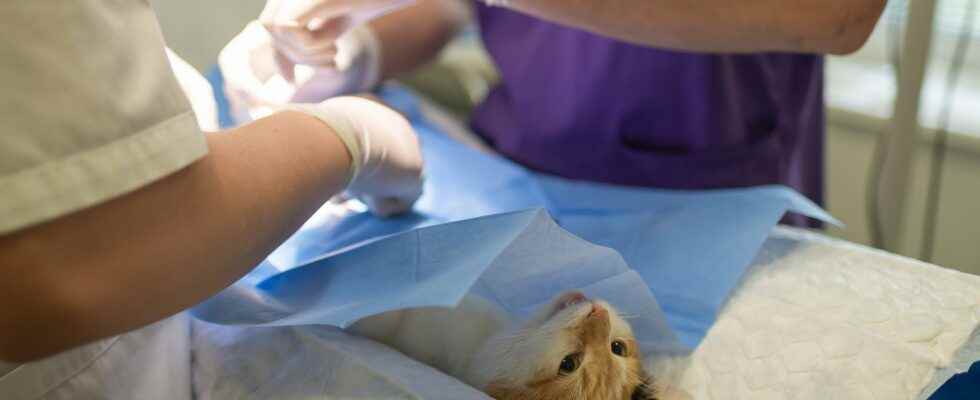(BFM Bourse) – The rise in prices is a real challenge for the two veterinary laboratories. Inflation made its way into the half-year accounts of Virbac and Vétoquinol with various consequences. For a local analyst, the room for maneuver on prices will probably be reduced for Virbac in 2023.
The half-year results of the two veterinary laboratories Vetoquinol and Virbac received an icy reception this Friday, the two titles showing the largest declines in the Paris market. Vetoquinol dropped more than 10% to 93.80 euros after losing up to 15% in the first exchanges while Virbac gave back 7.8% to 300 euros around 10:30 am.
Although Virbac recorded a clear increase in its half-year results and confirms most of its outlook for 2022, investors did not appreciate the reduction in the debt reduction target for the current year due to inflation in particular. For Vetoquinol, the price hike disrupted the pharmaceutical laboratory’s business, putting pressure on its profitability in the first six months of the year.
Degraded half-year profitability
The Vetoquinol group operates in a buoyant sector (animal health) but it is not immune to geopolitical and inflationary tensions. As early as April and the publication of its quarterly update, the company had already warned that it was exposed to the risk of inflation in the cost of purchasing raw materials and energy, caused by the Ukrainian conflict.
These inflationary risks have interfered in the half-yearly accounts of the pharmaceutical company. Over the first six months of 2022, Vetoquinol published current operating income (before amortization of assets acquired) down 5.3%, to 51.5 million euros for a turnover already published of 271 million. euros. The corresponding margin deteriorated by more than 3 points to 19% against 22.3% last year. In terms of net income group share, the figures presented by Vetoquinol are also down nearly 15% to 21.4 million euros.
Increase in marketing costs
The veterinary laboratory attributes this slippage in the accounts to a depreciation of 9.3 million euros in “a contracted and uncertain economic context” in Brazil. Personnel costs increased by 8%, while other purchases and external expenses increased by 11.3 million euros, mainly due to an increase in marketing and advertising costs related to the launch of new Essential products, including Felprev antiparasitic for cats.
In this context, Vetoquinol does not put forward a quantified outlook for 2022 in the face of inflationary pressures. However, the group recalled the main lines of its medium-term plan Ambition 2026, which will focus on brands with international potential.
“Overall, according to management, this plan should enable a doubling in the top 20 of the average size per product (i.e. 10 million euros versus 5 million euros in the previous plan), an average annual growth in turnover above the market (+3 to +5%) and an Ebitda margin ‘corridor’ of around 20% (versus 15-16%)”, recalls TP Icap Midcap in its note devoted to the results of Vetoquinol . The design office maintains its opinion to be kept on the file but updated its target price to 106 euros against 114 euros after the publication of Vetoquinol’s half-year accounts.
An inflationary context that penalizes deleveraging
As for Virbac, it is not the content of the half-yearly accounts that upset investors. The French pharmaceutical laboratory, exclusively dedicated to animal health, has indeed unveiled an operating profit which increased by 13%, to 115.5 million euros. Net income, group share rose by 7.7% to 77.5 million euros over the half-year.
Already published at the end of July, the veterinary laboratory had announced a turnover of 616.4 million euros for the first half, up 16.4% in published data and 12% at constant exchange rates and scope. .
The group is still aiming for revenue growth at constant rates and scope within a range of between 5% and 10%. Until the start of the year, management anticipated organic revenue growth of between 5% and 8% for 2022. Virbac also confirms its objective of a ratio of “current operating income before amortization of assets resulting from acquisitions” on ” revenue” around 15% at constant exchange rates, despite inflationary pressures (with voluntary overinvestment in R&D of around 1 point as a percentage of revenue compared to 2021) .
On the other hand, the market sanctioned the downward revision of Virbac’s debt reduction objectives. The debt reduction of the company is now expected around 30 million euros excluding dividends, while it provided for a reduction in debt “around 60 million euros” in a previous communication.
“The increase in our working capital requirement linked to the growth of our activity, to inflation, as well as to management decisions (safety stock for example) has led us to adjust our forecasts downwards. debt reduction for the year 2022”, explained Virbac. “The context will penalize deleveraging this year and we are factoring in the continuation of inflation in 2023,” note the analysts at TP Icap Midcap in their note of the day.
The year 2023 will include in the eyes of the analysts of TP Icap Midcap “more inflationary impact on a probably reduced price room for maneuver.” “Wage inflation should be sustained both in Europe and in the United States and the rise in raw materials, energy and transport could persist, perhaps temporarily limiting the increase in the margin while the magnitude in prices could become penalizing on volumes”, continues the research office which remains to be kept with a price target of 343 euros on Virbac.
Sabrina Sadgui – ©2022 BFM Bourse
Are you following this action?
Receive all the information about VIRBAC in real time:
